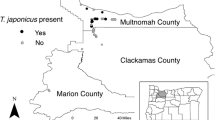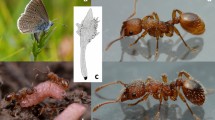Abstract
Males of the spined soldier bug,Podisus maculiventris (Heteroptera: Pentatomidae), produce an attractant pheromone that is exploited as a host-finding kairomone by a complex of parasitic species. The capability to catch hundreds of a generalist tachinid fly parasitoid,Euclytia flava, alive in traps baited with the pheromone ofP. maculiventris provided an opportunity to test the premise of the “new associations” biological control concept. The hypothesis that host species newly associated with a parasitoid are maladapted relative to native-native associations was tested by givingE. flava females a choice between native and exotic stink bugs (Heteroptera: Pentatomidae). WildE. flava females preferred to oviposit on exotic pentatomid species rather than indigenous, known host species, both in field traps baited with the pheromone of a native host and in the laboratory. Data presented here demonstrate that an invader may be vulnerable to native parasitoids in one aspect of the parasitism process (acceptance), yet go unrecognized as a potential host.
Similar content being viewed by others
References
Aldrich, J.R. 1985. Pheromone of a true bug (Hemiptera-Heteroptera): Attractant for the predator,Podisus maculiventris, and kairomonal effects, pp. 95–119,in T.E. Acree and D.M. Soderlund, (eds.). Semiochemistry: Flavors and Pheromones. de Gruyter, Berlin.
Aldrich, J.R. 1995. Chemical communication in true bugs and exploitation by parasitoids and commensals, pp. 318–363,in R.T. Cardé and W.J. Bell (eds.). Chemical Ecology of Insects II. Chapman and Hall, New York.
Aldrich, J.R., Kochansky, J.P., andAbrams, C.B. 1984. Attractant for a beneficial insect and its parasitoids: Pheromone of the predatory spined solider bug.Podisus maculiventris (Hemiptera: Pentatomidae).Environ. Entomol. 13:1031–1036.
Aldrich, J.R., Lusby, W.R., andKochansky, J.P. 1986. Identification of a new predaceous stink bug pheromone and its attractiveness to the eastern yellowjacket.Experientia 42:583–585.
Aldrich, J.R., Oliver, J.E., Lusby, W.R., Kochansky, J.P., andLockwood, J.A. 1987. Pheromone strains of the cosmopolitan pest,Nezara viridula (Heteroptera: Pentatomidae).J. Exp. Zool. 240:171–175.
Aldrich, J.R., Lusby, W.R., Marron, B.E., Nicolaou, K.C., Hoffmann, M.P., andWilson, L.T. 1989. Pheromone blends of green stink bugs and possible parasitoid selection.Naturwissenschaften 76:173–176.
Aldrich, J.R., Hoffmann, M.P., Kochansky, J.P., Lusby, W.R., Eger, J.E., andPayne, J.A. 1991a. Identification and attractiveness of a major pheromone component for NearcticEuschistus spp. stink bugs (Heteroptera: Pentatomidae).Environ. Entomol. 20:478–483.
Aldrich, J.R., Kochansky, J.P., Lusby, W.R., andBorges, M. 1991b. Pheromone blends of predaceous bugs (Heteroptera: Pentatomidae:Podisus spp.).Z. Naturforsch. 46C:264–269.
Buschman, L.L., andWhitcomb, W.H. 1980. Parasites ofNezara viridula (Hemiptera: Pentatomidae) and other Hemiptera in Florida.Fla. Entomol. 63:154–162.
Carayon, J. 1981. Dimorphisme sexuel des glandes tegumentaires et production de pheromones chez les Hemipteres Pentatomoidea.C.R. Acad. Sci. Ser. III 292:867–870.
Carruthers, R.I., andOnsager, J.A. 1993. Perspective on the use of exotic natural enemies for biological control of pest grasshoppers (Orthoptera: Acrididae).Environ. Entomol. 22:886–903.
Eger, E., Jr., andAbles, J.R. 1981. Parasitism of Pentatomidae by Tachinidae in South Carolina and Texas.Southwestern Entomol. 6:28–33.
Fitzgerald, T.D., St. Clair, A.D., Daterman, G.E., andSmith, R.G. 1973. Slow release plastic formulation of the cabbage looper pheromone cis-7-dodecenyl acetate: Release rate and biological activity.Environ. Entomol. 2:607–610.
Greathead, D.J. 1986. Parasitoids in classical biological control, pp. 289–318,in J. Waage and D. Greathead (eds.). Insect Parasitoids. Academic Press, New York.
Hokkanen, H.M.T. 1986. Polymorphism, parasites, and the native area ofNezara viridula (Hemiptera, Pentatomidae).Ann. Entomol. Fenn. 52:28–31.
Hokkanen, H.M.T., andPimentel, D. 1984. New approach for selecting biological control agents.Can. Entomol. 116:1109–1121.
Hokkanen, H.M.T., andPimentel, D. 1989. New associations in biological control: Theory and practice.Can. Entomol. 121:829–840.
Hokkanen, H.M.T., Greathead, D.J., andWaage, J.K. 1995. Test of the new association hypothesis in biological control: Tachinidae, Braconidae, and Eulophidae in the BIOCAT-database.Biocontrol Sci. Technol. In press.
Howarth, F.G. 1991. Environmental impacts of classical biological control.Annu. Rev. Entomol. 36:485–509.
Jones, W.A., Jr. 1988. World review of the parasitoids of the southern green stink bug,Nezara viridula (L.) (Heteroptera: Pentatomidae).Ann. Entomol. Soc. Am. 81:262–273.
Jones, W.A., Jr., andMcPherson, J.E. 1980. The first report of the occurrence of acanthosomatids in South Carolina.J. Ga. Entomol. Soc. 15:286–289.
Jones, W.A., Jr., Shepard, M.M., andSullivan, M.J. 1995. Incidence of parastism of pentatomid (Heteroptera) pests of soybean in South Carolina with a review of studies in other states.J. Agricult. Entomol. Submitted.
Lockwood, J.A. 1993a. Benefits and costs of controlling rangeland grasshoppers (Orthoptera: Acrididae) with exotic organisms: Search for a null hypothesis and regulatory compromise.Environ. Entomol. 22:904–914.
Lockwood, J.A. 1993b. Environmental issues involved in the biological control of rangeland grasshoppers (Orthoptera: Acrididae) with exotic agents.Environ. Entomol. 22:503–518.
McPherson, J.E. 1982. The Pentatomoidea (Hemiptera) of Northeastern North America with Emphasis on the Fauna of Illinois. Southern Illinois University Press, Carbondale. 240 pp.
Nechols, J.R., andKauffman, W.C. 1992. Introduction and overview, pp. 1–5,in W.C. Kauffman, and J.E. Nechols (eds.). Selection Criteria and Ecological Consequences of Importing Natural Enemies. Entomol. Soc. Amer., Lanham, Maryland.
Nechols, J.R., Kauffman, W.C., andSchaefer, P.W. 1992. Significance of host specificity in classical biological control, pp. 41–52,in W.C. Kauffman and J.E. Nechols (eds.), Selection Criteria and Ecological Consequences of Importing Natural Enemies. Entomol. Soc. Amer., Lanham, Maryland.
Oetting, R.D., andYonke, T.R. 1971. Biology of some Missouri stink bugs.J. Kans. Entomol. Soc. 44:446–459.
Pimentel, D. 1963. Introducing parasites and predators to control native pests.Can. Entomol. 95:785–792.
Pimentel, D., andHunter, M.S. 1992. Status of the biological control of pests.Evol. Trends Plants 6:11–15.
Stone, A., Sabrosky, C.W., Wirth, W.W., Foote, R.H., andCoulson, J.R. 1965. A Catalog of the Diptera of America North of Mexico. USDA Handbook, No. 276. U.S. Department of Agriculture, Washington, D.C.
Thomas, D.B. 1992. Taxonomic Synopsis of the Asopine Pentatomidae (Heteroptera) of the Western Hemisphere. Thomas Say Foundation Publication, Entomology Society of America, Lanham, Maryland.
Todd, J.W. 1989. Ecology and behavior ofNezara viridula.Annu. Rev. Entomol. 34:273–292.
Author information
Authors and Affiliations
Rights and permissions
About this article
Cite this article
Aldrich, J.R. Testing the “new associations” biological control concept with a tachinid parasitoid (Euclytia flava). J Chem Ecol 21, 1031–1042 (1995). https://doi.org/10.1007/BF02033806
Received:
Accepted:
Issue Date:
DOI: https://doi.org/10.1007/BF02033806




